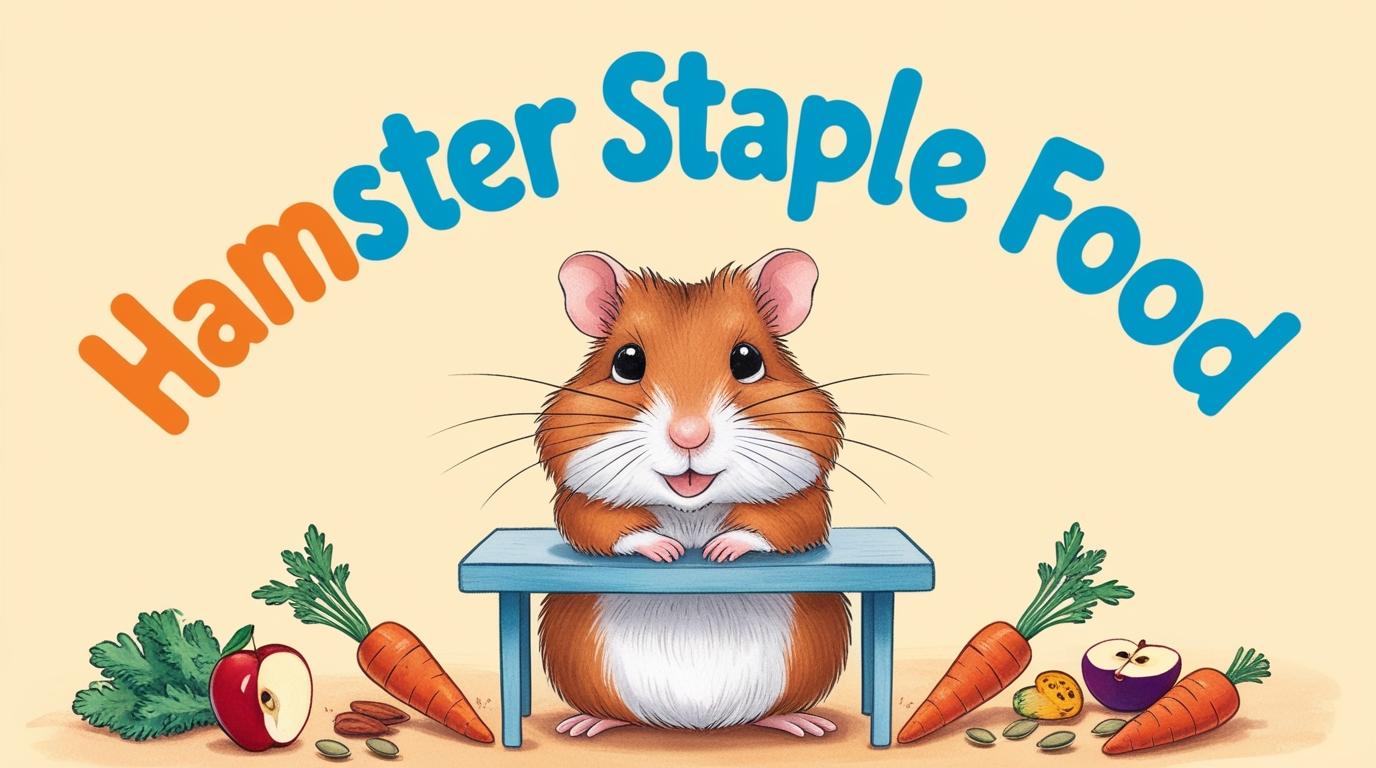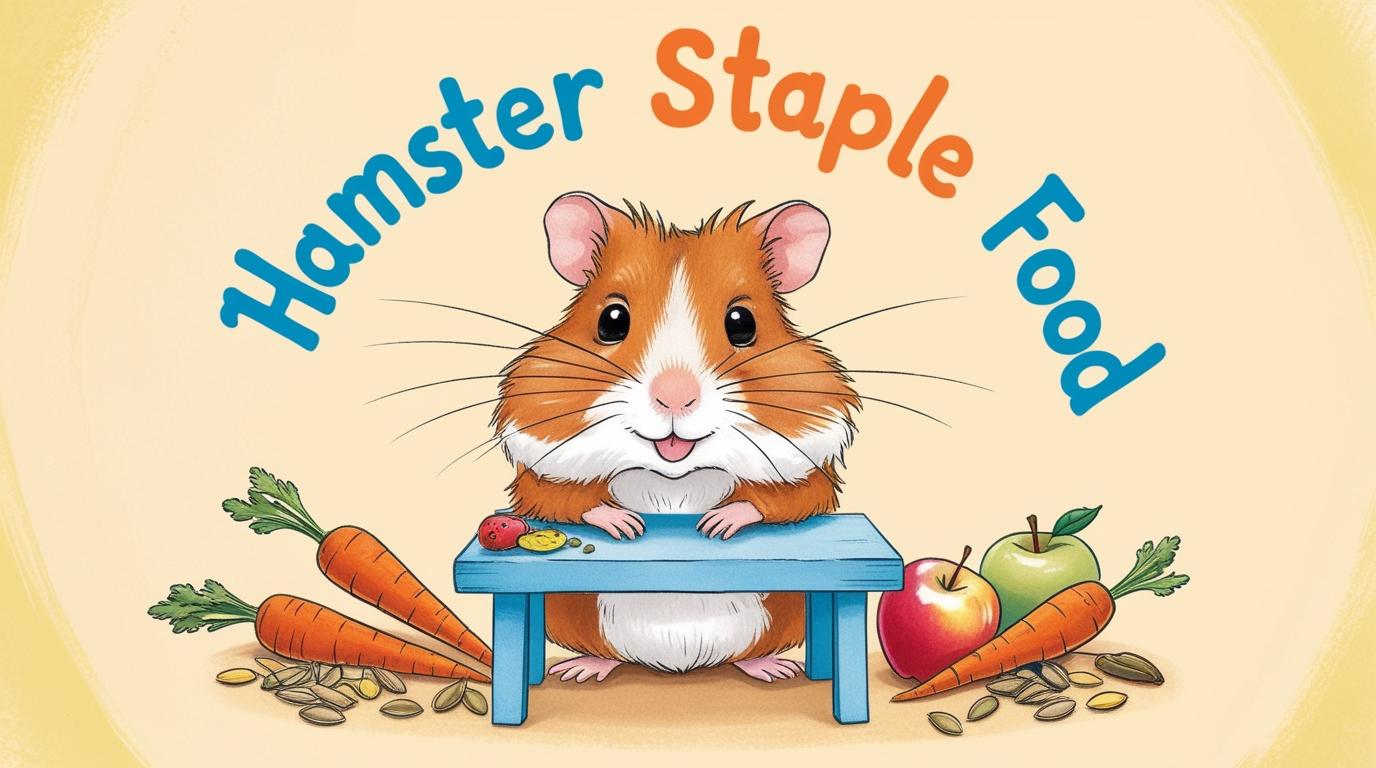
Hey there, fellow hamster enthusiasts! Today, we're diving into the world of hamster nutrition, specifically focusing on the backbone of their diet: staple food. As someone who's spent more time than I'd like to admit pondering over hamster food labels (and cleaning up the aftermath of dietary experiments), I'm here to share the lowdown on what should be filling your little buddy's food bowl day in and day out.
Why Staple Food Matters
Before we jump into the nitty-gritty, let's talk about why staple food is such a big deal. Picture this: you're at an all-you-can-eat buffet (sounds great, right?). Now imagine eating nothing but dessert for every meal. Sure, it might be fun for a day or two, but pretty soon, you'd start feeling pretty lousy. That's kind of what it's like for a hamster without proper staple food – except they can't even complain about it!
Staple food is the foundation of your hamster's diet. It's like the main course at a fancy dinner party, except this party lasts for your hamster's entire life. It provides:
- Essential nutrients for overall health
- The right balance of proteins, fats, and carbohydrates
- Necessary fiber for digestive health
- Dental wear to keep those ever-growing teeth in check
Trust me, you don't want a hamster with dental issues. I once had a hamster named Chomper who lived up to his name a little too well when his diet wasn't quite right. Let's just say my furniture has never been the same.
Commercial Hamster Food: The Go-To Staple
Now, drumroll please... the star of our show: commercial hamster food! This is the MVP of hamster nutrition, the bread and butter (or should I say seeds and pellets?) of their diet. But not all commercial foods are created equal. Let's break it down:
Types of Commercial Hamster Food
Seed Mixes: These are the classic hamster foods you probably picture when you think of hamster chow.
They typically contain:
- Various seeds (sunflower, pumpkin)
- Grains (wheat, oats, barley)
- Dried vegetables
- Sometimes dried fruits or pellets
- Pros: Variety, natural foraging behavior
- Cons: Hamsters might pick out favorites, leading to an unbalanced diet
Pellet or Block Diets: These are uniform pieces that contain all necessary nutrients.
- Pros: Balanced nutrition, prevents selective eating
- Cons: Less variety, might be less exciting for your hamster
Combination Diets: These mix seed mixes with pellets for the best of both worlds.
- Pros: Balanced nutrition with some variety
- Cons: Hamsters might still pick out favorites
Choosing the Right Staple Food
Alright, so you're standing in the pet store aisle, surrounded by colorful bags of hamster food, feeling a bit like you're in a rodent version of a grocery store. How do you choose? Here are some tips:
- Check the protein content: Look for foods with 15-20% protein. Your hamster needs protein to build those strong muscles for all that wheel-running.
- Look for a variety of ingredients: A good mix should have multiple types of seeds, grains, and maybe some dried veggies.
- Avoid artificial colors and flavors: Your hamster doesn't need food that looks like a rainbow. Natural is best.
- Consider your hamster's age: Young, pregnant, or nursing hamsters might need higher protein content.
Read reviews: See what other hamster parents are saying. But take it with a grain of salt – hamsters, like people, can be picky eaters.
Here's a quick comparison table of what to look for in hamster staple food:
| Nutrient | Ideal Percentage |
|---|---|
| Protein | 15-20% |
| Fat | 4-5% |
| Fiber | 6-15% |
Now, let's address the elephant (or should I say, hamster) in the room: the great seeds vs. pellets debate. It's like the hamster world's version of "tastes great, less filling." Here's my take:
Seed Mixes
Pros:
- More natural, mimics wild foraging behavior
- Usually more appealing to hamsters
- Provides variety
Cons:
- Hamsters might selectively eat, leading to imbalanced nutrition
- Higher fat content if eaten improperly
- Might lead to obesity if overfed
Pellets
Pros:
- Balanced nutrition in every bite
- Prevents selective eating
- Often fortified with additional nutrients
Cons:
- Less exciting for hamsters
- May lead to boredom
- Some hamsters might refuse them initially
My personal preference? A high-quality seed mix with some pellets mixed in. It's like giving your hamster a balanced meal with a side of fun. Just keep an eye out to make sure they're not just picking out the "junk food" equivalent.

Supplementing Staple Food
Now, before you think staple food is all your hamster needs, let me stop you right there. While it should make up about 90% of their diet, even hamsters need a little variety in their lives. Here's what you can add to spice things up:
- Fresh vegetables: Small amounts of carrots, cucumber, or leafy greens can add some extra nutrients and excitement.
- Proteins: Occasional treats like a tiny bit of boiled egg or a mealworm can be a protein-packed snack.
- Fruits: Very small amounts of hamster-safe fruits can be a sweet treat. But remember, fruits are like hamster candy – a little goes a long way!
- Commercial treats: Use sparingly. These are often high in sugar and should be given as occasional rewards, not daily snacks.
Remember, treats should make up no more than 10% of your hamster's diet. I learned this the hard way with my hamster, Chubby Charlie. Let's just say he lived up to his name a little too well before we got his diet sorted out!
Feeding Schedule: When and How Much
Now that we know what to feed, let's talk about when and how much. Hamsters are nocturnal creatures, which means they're most active at night. Here's a typical feeding schedule:
- Evening feeding (main meal): Offer the bulk of the staple food in the evening when your hamster wakes up. About 1-2 tablespoons for an average-sized hamster.
- Morning check: Remove any fresh foods that might have been left overnight to prevent spoilage.
- Midday snack (optional): A small veggie or protein treat can be offered, but don't be surprised if your hamster is snoozing and ignores it.
Remember, hamsters are natural hoarders. Don't be alarmed if you see your little friend stuffing their cheeks full of food – they're just saving it for later! However, do check their stashes occasionally to remove any spoiled food.
Common Mistakes to Avoid
As someone who's made pretty much every hamster-feeding mistake in the book (sorry, Tubby Tim), let me save you some trouble:
- Overfeeding: Hamsters are small, and their nutritional needs are too. Overfeeding can lead to obesity.
- Too many treats: Treats are great, but they shouldn't replace staple food.
- Sudden diet changes: Introduce new foods gradually to avoid digestive upset.
- Feeding human food: Not all human foods are safe for hamsters. Stick to hamster-approved snacks.
- Ignoring water: Fresh, clean water is just as important as food. Change it daily!
Special Dietary Considerations
Just like us humans, some hamsters might have special dietary needs. Here are a few scenarios:
- Young hamsters: May need higher protein content for growth.
- Pregnant or nursing hamsters: Require more protein and calcium.
- Older hamsters: Might need softer foods if they have dental issues.
- Overweight hamsters: May need a reduced-calorie diet (consult with a vet).
Always consult with a vet if you're unsure about your hamster's specific needs. After all, they're the real experts (though I like to think I come in a close second after all my hamster adventures).

Conclusion
And there you have it, folks – everything you need to know about hamster staple food. Remember, a balanced diet is key to a happy, healthy hamster. Staple food should be the star of the show, with treats playing a supporting role.
Keep in mind that every hamster is unique. What works for one might not work for another. Pay attention to your furry friend's preferences and health, and don't be afraid to make adjustments as needed.
At the end of the day, providing proper nutrition is one of the most important things you can do for your hamster. It might seem like a lot to remember, but trust me, once you get the hang of it, it'll become second nature. And your hamster will thank you for it – well, maybe not in words, but in wheel sprints and adorable cheek stuffing!
Now go forth and feed those adorable little furballs! And remember, if your hamster ever gives you the side-eye for not providing an all-you-can-eat sunflower seed buffet, just remind them that you're looking out for their health. They might not appreciate it now, but their future selves (and their tiny hamster jeans) will thank you.
